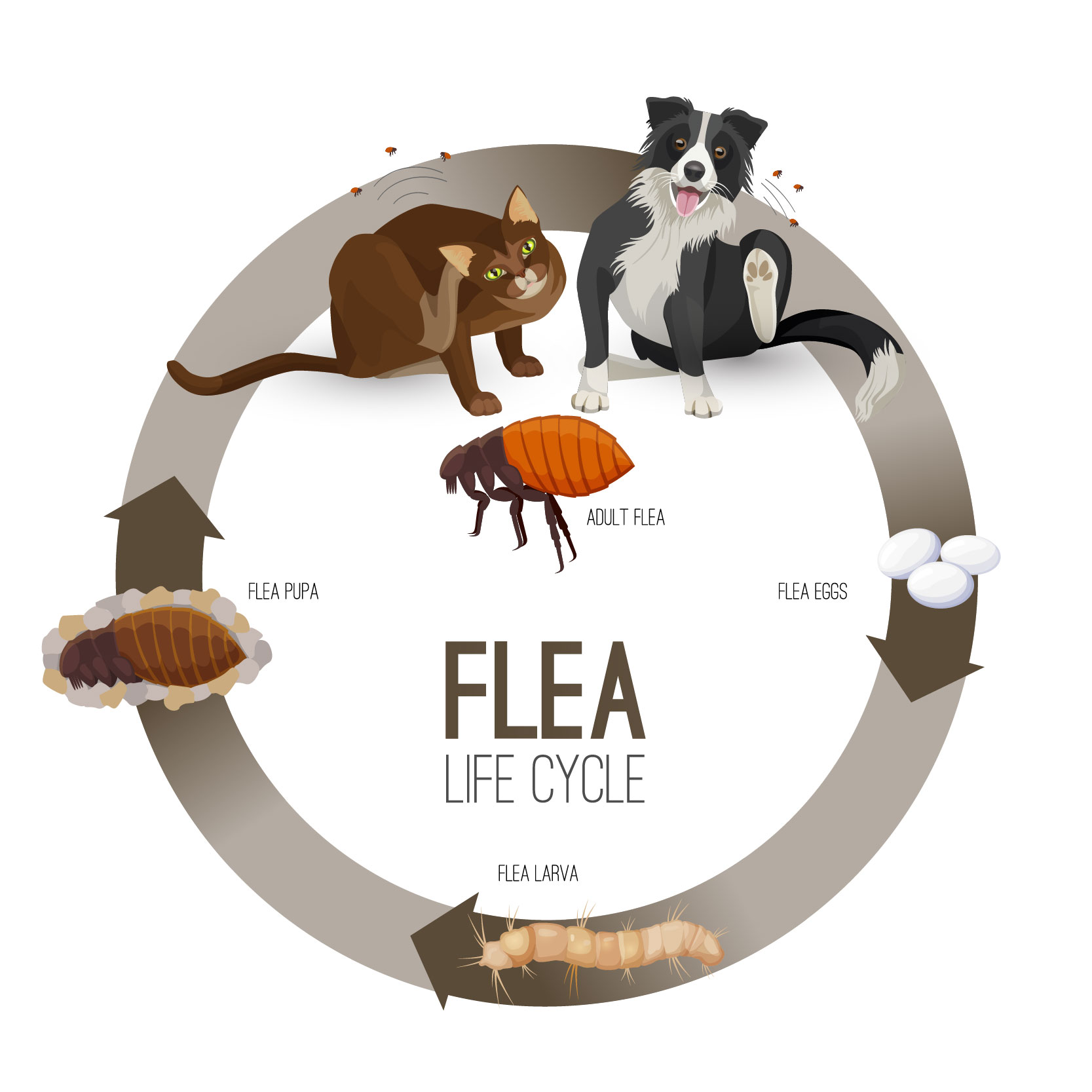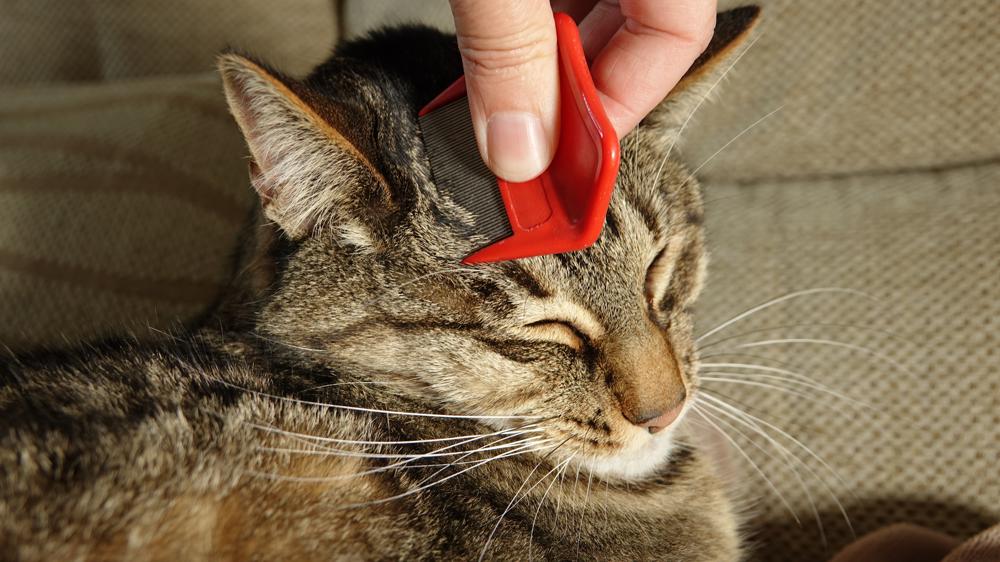 This article was featured in WYDaily on 10/7/22.
This article was featured in WYDaily on 10/7/22.
Autumn is one of the most active seasons for fleas. These notoriously unwanted pests are so tiny, yet can wreak major havoc for pets, owners, and their homes. The Heritage Humane Society shares tips for preventing fleas and handling infestations so you and your pet can stay problem-free and save money.

According to the American Kennel Club, flea season in Virginia lasts from March through December. While its common to associate fleas with warmer months, the troublemakers actually prefer slightly cooler temperatures, work hard to find a snuggly spot, and strive to avoid sunlight.
Pesky little bloodsuckers
With more than 200 species of fleas affecting unprotected animals and pets, these can also transmit disease such as Lyme disease and Rocky Mountain spotted fever, as well as cause tapeworm infections and anemia. Some pets are very sensitive to fleabites and suffer from serious allergic reactions of itchy, red, and scabby skin and even hair loss. Even their human companions can suffer from bites triggering unrelenting scratching and discomfort.
Fleas are resiliently fierce storm troopers. They are built to survive, eat, and reproduce – rapidly. They can jump 4 to 5 feet. An adult female lays about 20 eggs at a time. In her lifetime (depending on conditions, up to 1-1/2 years), she may produce hundreds, even thousands of eggs. If laid on pets, the eggs can also fall off and start to be scattered around your house and yard. The eggs hatch in about a week into larvae. The larvae then pupate by spinning cocoons, in which they can finish their development in a week or depending on the conditions, can stay in their cocoons for up to six months. For every single adult flea you see, there are about 10 cocoons, 35 larvae and 50 eggs hiding in carpets, pet beds, cracks, corners, and furniture. One blood meal can keep a flea satiated for up to two months tricking people who think they’ve destroyed them when they’ve just gone dormant. Treatment has to be swift, far-reaching, and relentless until all signs of fleas, larvae, and eggs are gone.

Scavenger hunt time
Fleas are well adept at playing hide and seek. Pay close attention to the base of the tail, under the legs, around the neck, and the belly. Use a fine-toothed flea comb to carefully comb through all of the fur from root to end.
Check your pets bed for the little crawlers and for tiny, white eggs. Also check sofas, chairs, rugs, and anywhere else your pet likes to relax.

Treatment time
At The Heritage Humane Society treats and prevents fleas, the shelter medical team is quick to treat arriving homeless pets. All cats and dogs receive a chemical flea and tick preventative. If they arrive infested, they receive a nitenpyram treatment, an oral usually one-time treatment more commonly known as Capstar. Within 30 minutes, fleas start dying and lasts for 24 hours. This is followed with the chemical flea and tick preventative. Should a puppy or kitten come in with fleas and ticks and they are less than 8 weeks old or if a nursing mother arrives, the shelter team bathes them using Dawn dish soap and combs the fleas out of their fur.
The Heritage Humane Society also recommends treating indoor-only cats with a flea preventative. Humans can bring in the wingless acrobats on their clothes and the uninitiated are often surprised that their indoor cats can also suffer from fleas.
There are many flea treatments for the home and yard on the market. Bringing in the help of a licensed exterminator is one solution. Another is to tackle the creepy, crawlies with yard spray paying close attention to wood piles and tall grass. Inside your home, vacuum often including furniture and immediately empty the canister or bag. Flea love to hide in tall grass, so keeping your lawn short will help eliminate these hiding places.
Pro tip: If your pup takes frequent rides with you in the car, be sure to treat the interior should you notice fleas on your pet or in your house.
Alternatives
While the nitenpyram and chemical flea and tick preventatives are widely accepted and successful in killing or preventing fleas, there are also alternatives to explore. With the growing interest in eco-friendly and homeopathic solutions, there are alternatives to traditional chemical treatments.
It’s important to understand the difference between treatments and preventatives. Geranium oil is proven to be 400% more effective than commonly referenced citronella at repelling fleas, ticks, and mosquitos. Many people purposely plant geraniums around their house for this reason in addition to their beauty. Neem products, natural-based powders such as calcium carbonate or diatomaceous earth-based ones are non-toxic to pets, people, and the environment. Essential oils including those in flea-destroying and preventative shampoos have long proven effective. Remember, dogs and cats have significantly stronger smelling powers than human, so pay close attention to instructions including diluting essential oils to protect your pet. Speaking to your veterinarian first is always recommended.
Unable to adopt, but wish to help
There are many ways to help pets right here in the community. Consider sponsoring the adoption fees. If interested, email or call the Heritage Humane Society Adoption Team at [email protected] or 757-221-0150 ext.0. Share their stories with family and friends. Make an online donation, donate needed items such as timothy hay, small critter bedding, guinea pig and rabbit food/treats, small critter toys, purchase items from the shelter’s onsite ReTail Store such as small critter toys, treats, and food, or join The Heritage Humane Society foster community.
To learn more, visit HeritageHumane.org or call 757-221-0150. Heritage Humane Society is located at 430 Waller Mill Road, Williamsburg, VA 23185.
Sponsored content by




